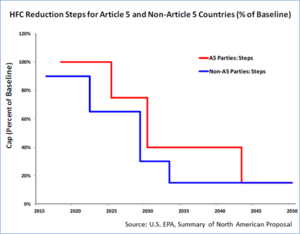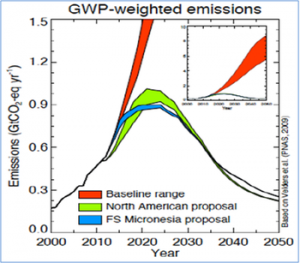Over the weekend President Obama and Chinese President Xi agreed to work together to phase-down hydrofluorocarbons (HFCs)—a "super greenhouse gas". They agreed to work under the Montreal Protocol – the 25 year old treaty that successfully saved the ozone layer and is now working to ensure the safety and climate friendliness of the replacement chemicals. This is very important since China had joined a limited number of countries in resisting the effort by more than 110 countries to secure an agreement to phase-down these chemicals. Effective implementation of the agreement will help address climate change and reduce the growth in both countries of this potent heat-trapping chemical that is primarily used in air conditioners, refrigerators, and industrial applications. (As my colleague David Doniger said this agreement is a "big deal" and one of the top three actions that these two countries could agree to as we have previously noted).
"to work together and with other countries through multilateral approaches that include using the expertise and institutions of the Montreal Protocol to phase down the production and consumption of HFCs…"
 The use of HFCs is projected to grow significantly in the coming years as countries phase out ozone-depleting chemicals and as the use of air conditioners and refrigerators grow – especially in developing countries (see figure*). If left uncontrolled, global emissions of HFCs in 2050 are projected to be 28-45% of the emissions allowed under a global warming reduction pathway. So making the transition to chemicals with a lower impact on the climate could make an important dent in addressing climate change.
The use of HFCs is projected to grow significantly in the coming years as countries phase out ozone-depleting chemicals and as the use of air conditioners and refrigerators grow – especially in developing countries (see figure*). If left uncontrolled, global emissions of HFCs in 2050 are projected to be 28-45% of the emissions allowed under a global warming reduction pathway. So making the transition to chemicals with a lower impact on the climate could make an important dent in addressing climate change.
Fortunately, there are replacements that have less heat-trapping potency. The Montreal Protocol's Technology and Economic Assessment Panel (TEAP) – the technical body made of scientists – has identified existing and emerging technology that can economically eliminate almost every HFC use. And analysis from the U.S. Environmental Protection Agency found that many alternatives are "available now" and alternatives for nearly all other uses are expected in a few years. Working with partners in India, we have also identified many business reasons for Indian companies to make the transition.
 To speed up the transition, two groups of countries have proposed phase-down proposals under the Montreal Protocol – the "North American proposal" (from the U.S., Mexico, and Canada) and the Federated States of Micronesia proposal. Both contain features similar to previous phase-down rounds in the Montreal Protocol: (1) developed countries lead with the phase-down; (2) developing countries follow with a several year delay in their phase-down schedule (see figure*); and (3) through a dedicated fund developed countries provide technical and financial support to help developing countries with the transition. The Montreal Protocol fund has delivered over the years – with more than $3 billion provided for the various chemical transitions, helping developing countries to more quickly phase out ozone-depleting chemicals. An agreement under the Montreal Protocol would unlock resources now for reducing production of global warming HFCs – countries wouldn't have to wait several years for the possibility of funding coming through other venues (e.g., the climate negotiations).
To speed up the transition, two groups of countries have proposed phase-down proposals under the Montreal Protocol – the "North American proposal" (from the U.S., Mexico, and Canada) and the Federated States of Micronesia proposal. Both contain features similar to previous phase-down rounds in the Montreal Protocol: (1) developed countries lead with the phase-down; (2) developing countries follow with a several year delay in their phase-down schedule (see figure*); and (3) through a dedicated fund developed countries provide technical and financial support to help developing countries with the transition. The Montreal Protocol fund has delivered over the years – with more than $3 billion provided for the various chemical transitions, helping developing countries to more quickly phase out ozone-depleting chemicals. An agreement under the Montreal Protocol would unlock resources now for reducing production of global warming HFCs – countries wouldn't have to wait several years for the possibility of funding coming through other venues (e.g., the climate negotiations).
 Avoiding this HFC growth could prevent an amazing amount of heat-trapping emissions. For example, worldwide HFC reductions under the North American proposal would equal more than 90 billion metric tons of CO2 through 2050, with similar reductions in the Micronesia proposal (see figure). That is equivalent to eliminating 12 times the current annual greenhouse gas emissions of the United States. A phase-down along these lines would lead to a noticeable reduction in the rate of climate change.
Avoiding this HFC growth could prevent an amazing amount of heat-trapping emissions. For example, worldwide HFC reductions under the North American proposal would equal more than 90 billion metric tons of CO2 through 2050, with similar reductions in the Micronesia proposal (see figure). That is equivalent to eliminating 12 times the current annual greenhouse gas emissions of the United States. A phase-down along these lines would lead to a noticeable reduction in the rate of climate change.
Obviously this agreement doesn't take the onus off of the U.S., Europe, and other developed countries to act at home. As part of the greenhouse gas standards for cars in the U.S., car makers are replacing HFCs with chemicals that have less than one percent of the climate impact. And a number of groups, including NRDC, are pushing for a broader phase-down in the U.S. under existing law. Similarly, the E.U. currently has a phase-out of high-GWP coolants for new cars through their "Mobile Air Conditioner Directive". And the E.U. has proposed an "F-gas Directive" that will phase down all uses of HFCs by two-thirds from today's levels – they expect to finalize that proposal this year or early next year.
For a number of years countries have been stuck at the stage of: "should we begin such a negotiation". More than 110 countries have supported efforts to negotiate a phase-down of HFCs under the Montreal Protocol. But those negotiations have been stuck as China, India, and Brazil have resisted negotiating a phase-down for a variety of reasons.
In a couple of weeks countries will be meeting in Bangkok, Thailand for the next round of the Montreal Protocol negotiations. This agreement should remove the Chinese resistance to beginning that negotiation. And maybe even to sealing a deal at the Montreal parties' annual meeting in October.
* "Non-A5" under the Montreal Protocol are the developed countries and "A5" are the developing countries.


